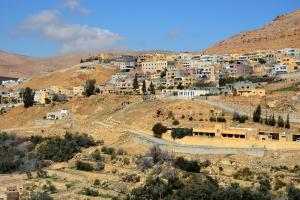
Cities are a major driver of climate change, responsible for an estimated 75% of all carbon dioxide emissions globally. With two thirds of humanity projected to live in cities by 2050, cities are at the center of climate action. We need solutions to reduce urban greenhouse gas emissions and develop healthier, more sustainable and climate resilient cities.
Sustainably managed urban trees and forests are a powerful nature-based solution to tackle these climate adaptation and mitigation challenges. They can cool temperatures in cities by up to 8 degrees Celsius. This reduces the urban heat island effect, saving lives and reducing energy demand for cooling. In addition, they increase resilience to floods and provide habitats for biodiversity.
Such benefits can be particularly relevant in dry cities. Dry cities are located in drylands which suffer water stress or scarcity at some point in a typical year. Some cities are dry because of their location in arid environments, with low levels of fresh water, precipitation, or both. Others are dry because of a temporary scarcity of water, or drought, influenced by local hydrology, human activities and more and more because of climate change.
Drylands cover 15% of Latin America, 66% of Africa, 40% of Asia, and 24% of Europe. Examples of dry cities include: Cairo, Doha, Dubai, Marrakesh (Middle East and North Africa); Athens, Istanbul, or Madrid in Europe; Baku, Bishkek and Tashkent (Caucasus and Central Asia); La Paz, Lima and Monterrey (Latin America), or Las Vegas or Phoenix in the United States.
In the coming years, droughts and water scarcity exacerbated by climate change will affect an increasing number of cities, with many experiencing heat and weather extremes. Faced with water stress and scarcity, dry cities experience greater challenges in sustaining and expanding urban trees and require national action and support to harness the benefits of urban forestry while judiciously managing water. Already today, an estimated 150 million people live in cities that have perennial water shortage.
To help them address these issues, UNECE and the World Green Economy Organization (WGEO) launched the Trees in Dry Cities Coalition at COP28. The collation is supported by many other partners including countries, cities, UN agencies and experts.
“With the global population becoming increasingly urban, and the world becoming hotter and drier, the relevance of initiatives, such as a Trees in Dry Cities Coalition, is becoming ever more important”, declared UNECE Executive Secretary Tatiana Molcean. “This coalition will build upon the success of UNECE’s Trees in Cities Challenge, thanks to which more than 80 cities worldwide have pledged to plant over 12 million trees. If properly managed over time, trees are a good investment, with benefits exceeding costs by roughly 5 to 1.”
Under the auspices of the Trees in Cities Challenge and its Tree Policy Action Lab (Tree PAL), in collaboration with the WGEO Cities Platform, the new coalition will support city pilots that inform national policy dialogue and recommendations to systemically drive and scale the sustainable management of urban trees and forests as a climate and SDG solution for dry cities across different regions of Asia, Africa, Europe, and Latin America.

